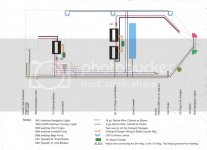We have folks asking how to wire a boat, so I decided to put together some basic information in a sticky for easy reference. If you have something to add or an item that needs to be corrected PM me.


Adding a second Battery
First -- there are two electrical systems on a boat. 1) the engine harness runs from the engine to the front of the boat. It gets its power from the two large battery cables connected to the start battery. That power system feeds the ignition switch and powers the gauges when the key is turned on. So issue #1 in your plan is you do not disconnect gauges from that circuit put them on another battery. You have no way to turn them on and off unless you add yet another switch which is simply a nonsense approach. Putting other stuff on the "house" battery is certainly a valid plan but then you don't need the switch to do that. 2) The second system in the boat is the two smaller wires that run to the circuit breaker or fuse panel in the boat. It is this circuit that powers everything else in the boat. Now then, there are many ways to wire a switch but it all boils down to "protecting the start battery" is it not? Well then, the best way to do that is wire everything to the COM terminal on the switch. You then have the option of switching to BAT 2 when parked which prevents draw on the start battery. Underway you can set the switch to 1, 2, or both to charge the selected battery or batteries.
Here is a simple wiring diagram for a dual battery switch. All loads get connected to the COM terminal. Note that all cables in this diagram must be the same gauge or larger than the regular battery cables. Wires feeding the loads need only be sized appropriately for that load.



Adding a second Battery
First -- there are two electrical systems on a boat. 1) the engine harness runs from the engine to the front of the boat. It gets its power from the two large battery cables connected to the start battery. That power system feeds the ignition switch and powers the gauges when the key is turned on. So issue #1 in your plan is you do not disconnect gauges from that circuit put them on another battery. You have no way to turn them on and off unless you add yet another switch which is simply a nonsense approach. Putting other stuff on the "house" battery is certainly a valid plan but then you don't need the switch to do that. 2) The second system in the boat is the two smaller wires that run to the circuit breaker or fuse panel in the boat. It is this circuit that powers everything else in the boat. Now then, there are many ways to wire a switch but it all boils down to "protecting the start battery" is it not? Well then, the best way to do that is wire everything to the COM terminal on the switch. You then have the option of switching to BAT 2 when parked which prevents draw on the start battery. Underway you can set the switch to 1, 2, or both to charge the selected battery or batteries.
Here is a simple wiring diagram for a dual battery switch. All loads get connected to the COM terminal. Note that all cables in this diagram must be the same gauge or larger than the regular battery cables. Wires feeding the loads need only be sized appropriately for that load.

Last edited:

